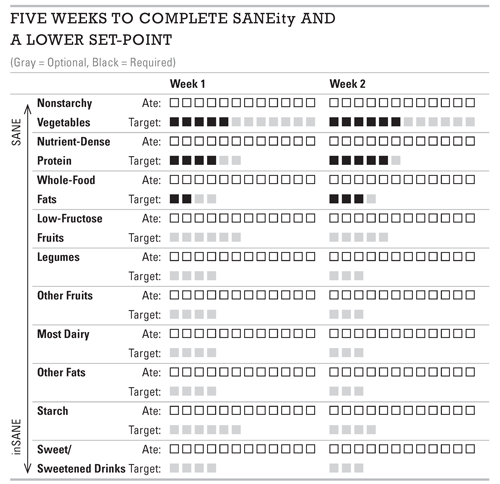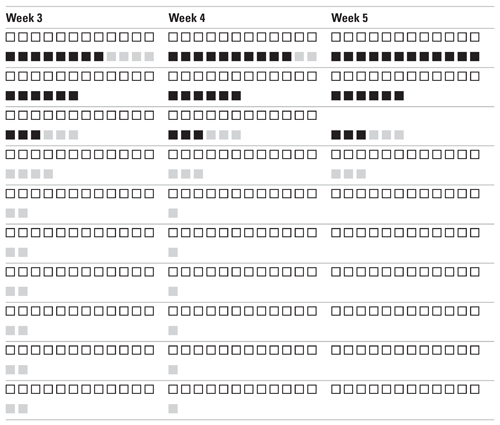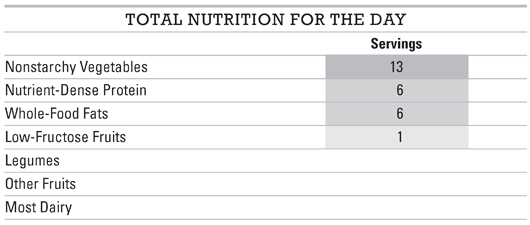

Five Weeks to Complete SANEity
Earlier we applied the teachings of the eighteenth-century German philosopher Immanuel Kant to fat loss and health. We covered how anything we do to boost wellness must be continued or our health will suffer. Therefore, we should skip any wellness program that we cannot keep up forever. A seven-day cleanse may be challenging, but what happens on day eight?
With Kant’s philosophy in mind, we’re going to ease our way into our new lifestyle. “Calm, gradual, and patient” is the right formula for the long term; all-or-nothing approaches are doomed to failure. Compare trying to be more active by attempting to run ten miles right now versus walking five more minutes every day while slowly adding pep to your step. Which is more likely to help you be more active in the long term? Remember, we’re focused on the next thirty years and beyond, not the next thirty days.
With a lifetime of fitness in mind, we’re going to make simple changes to the way we eat and exercise over five weeks. Each week we will swap a few more starches and sweets for a few more nonstarchy vegetables, nutrient-dense proteins, whole-food fats, and low-fructose fruits, and we’ll add a little more resistance to our smarter exercise. We’ll use a simple food tracker to keep general tabs on what we’re eating (see the table below). The black squares represent a serving of a food we need to lower our set-point. Gray squares represent a serving of a food we can eat if we would like to. The empty squares are what we check off when we eat.

It may be helpful to make copies of the food tracker so you can check off the boxes day by day. Also keep in mind that it is OK to eat more nonstarchy vegetables. The tracker shows daily minimums for nonstarchy vegetables. The more nonstarchy vegetables we eat, the healthier and slimmer we will be.
Also keep in mind that just as we want to avoid hunger, we also want to avoid feeling uncomfortably full. Use this tracker as a guide, but listen to your body. If you are not hungry and are on track to eat at least three 30-gram servings of protein and at least eight servings of nonstarchy vegetables and some essential fats, you do not need to make yourself uncomfortably full. Use the serving-size guidelines we outlined earlier for nonstarchy vegetables, nutrient-dense protein, whole-food fats, and low-fructose fruits. In a few pages we’ll look at some additional guidelines to help determine how many serving boxes you should check each time you eat. Also, note that the serving-size information given on food labels is generally accurate. To see this for yourself, look at a container of your favorite starch or sweet and note how tiny a serving size is.

Keep in mind that everything related to serving sizes and number of servings that we cover here is a general guideline. It is easy to get mired in details and to complicate things in talking about servings and serving sizes. Let’s stay focused on the big picture and use these guidelines to estimate our intake as accurately as we can. Nobody is overweight because of calculating servings wrong. People become overweight because they got clogged from bad information that leads to chronic consumption of the wrong quality of food.
As a general rule, most people wildly underestimate their starch, sweets, oil, and cheese intake. A bagel is at least four servings of starch, not one. A big bowl of enriched sweetened cereal is four servings of starch and four servings of sweets, not one serving of starch. It’s easy to eat four servings of pasta in a single sitting.
ADDITIONAL SERVING-SIZE GUIDES
LEGUMES: A serving is the size of a loose fist or 1 cup.
OTHER FRUITS: A serving is the size of a fist, 1 cup, or 1 medium-size fruit.
1 banana
2 plums
15 grapes
1 apple
1 peach
MOST DAIRY: A serving of butter is the size of the tip of your thumb (one teaspoon). A serving of cheese is about the size of your thumb. A serving of milk or high-sugar yogurt is 1 cup (eight ounces). Most people could easily eat four servings of butter or cheese but only a serving or two of milk or yogurt in a sitting. Baked goods can saturate you with butter before you know it. Every time you eat pizza, you are likely to be eating over four servings of cheese. Butter and cheese are easy to overeat.
OTHER FATS: An extremely fatty cut of conventional meat the size of your palm is two or three servings. One teaspoon of oil is also a serving. Aside from a few guys trying to prove something, most people would stop eating fatty meat naturally at two or three servings in a single sitting. However, it is extremely easy to overeat oil. Eat anything fried and you will easily consume at least four servings of oil.
STARCHY VEGETABLES/STARCH: Serving sizes vary. The key point is that a serving of starch is small. For example, a bag of popcorn can easily contain eight servings. Starches are extremely easy to overeat because they are dry and low in fiber and protein. Most people overeat starch daily without knowing it. When ranchers want to fatten livestock, they stop feeding them nonstarchy plants (grass) and start feeding them starch (generally corn). If you do not want to fatten yourself, avoid starch, especially in these common excess quantities.
bagel ![]() at least 4 servings
at least 4 servings
muffins ![]() at least 3 servings
at least 3 servings
baked potato ![]() at least 3 servings
at least 3 servings
french fries ![]() at least 4 servings
at least 4 servings
a traditional portion of pasta or rice ![]() at least 4 servings
at least 4 servings
a traditional bowl of cereal ![]() at least 4 servings
at least 4 servings
baked goods ![]() at least 4 servings
at least 4 servings
SWEETS/SWEETENED DRINKS: Ten grams of “sugar” (anything with calories that is added to food to make it sweeter) is a serving. Sweets are the easiest food to overeat. Some sweeteners aren’t even recognized as food by the body and never trigger a full feeling. This is why you can take in three servings of sweets by drinking a soda and still have plenty of room for a pink slime burger and fries cooked in toxic trans fats. Traditional portions of sweets and sweetened drinks contain three to eight servings. The fastest way to gain fat and damage your health is to eat and drink sweeteners.
can of soda ![]() at least 3 servings
at least 3 servings
desserts at ![]() least 4 servings
least 4 servings
a traditional bowl of sweetened cereal ![]() at least 4 servings
at least 4 servings
fruit juice ![]() at least 3 servings
at least 3 servings
A SAMPLE DAY
Before we move on to the smarter exercise program, let’s look at a typical day on a SANE eating program, with typical foods and serving estimations for what you’ll be eating. Again, note that the serving sizes are intentionally approximations. Please don’t sweat the small stuff. As Dr. John Yudkin, of the University of London, puts it, “There is no point in worrying about imaginary dangers. If you do, you will be likely to go on overlooking the real dangers.”179 Dedicate all your attention to healing your body with at least ten servings of nonstarchy vegetables, 100 to 200 grams of protein in at least 30-gram doses, whole-food fats, low-fructose fruits, and smarter exercise. Your body is miraculous—it will take care of the rest.
What I Ate Today: |
SMART Translation: |
Breakfast: 2 eggs and 6 egg whites scrambled with a lot of vegetables and ham, green tea |
1.5 nutrient-dense protein, 3 nonstarchy |
Lunch: Stir-fried chicken with a lot of vegetables, green tea |
1.5 nutrient-dense protein, 1 other fat, 3 nonstarchy vegetable |
Optional snacks: SANE pancakes, raw-sugar snap peas and baby carrots, green smoothie, drinking lots of water |
1 whole-food fat, 1 nutrient-dense protein, 4 nonstarchy vegetable |
Dinner: A lot of baked salmon, grilled vegetables, decaf green tea, SANE peanut butter mousse |
2 nutrient-dense protein, 3 nonstarchy vegetables, 3 whole-food fats |


We will cover a full week of SANE recipes and how to simplify cooking shortly, but first let’s explore our smarter exercise program.
Is SANE Eating the Same for Children and Adults?
Yes and no. Yes, in that the same foods are SANE for children and adults. No, in that eating Satisfying, unAggressive, Nutritious, and inEfficient food is more important for children because
• Children require more nutrition than adults.
• Children are more susceptible to food-related behavior problems.
• Fat cells never go away.
• The habits children form affect them forever.
Children Require More Nutrition Than Adults
Water-, fiber-, and protein-rich foods contain more nutrition per calorie than any other foods. A SANE child is optimizing growth and development with the most essential vitamins, minerals, proteins, and fats possible.
Children Are More Susceptible to Food-Related Behavior Problems
Starches and sweets are dramatically more Aggressive than SANE foods. They release a short burst of energy into the body. This causes a brief energy high followed by longer-lasting lethargy. Still developing mentally and emotionally, children are doubly affected by these highs and lows; that is why they start bouncing off the walls and have a hard time concentrating after eating starches and sweets.
Fat Cells Never Go Away
Once fat cells are made, we cannot get rid of them; we can only shrink them. This is why helping our children avoid excess body fat is so important and why childhood obesity is so heartbreaking. Once a child develops new fat cells, he will have a harder time staying slim for the rest of his life because those fat cells will never go away. They can be shrunk, but will forever predispose that child to storing excess body fat. In fact, the American Heart Association found that 70 to 80 percent of overweight children remain overweight their entire lives.180
The Habits Children Form Affect Them Forever
The habits we learn as children stick with us. When we teach our children healthy habits, we make it dramatically easier for them to keep themselves fit and healthy for the rest of their lives.